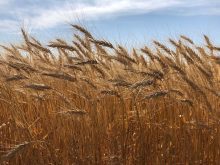Devils Lake, North Dakota | Reuters – U.S. spring wheat crops in northwest and north-central North Dakota are expected to produce the highest yields since at least 1994, the Wheat Quality Council said on an annual tour on Wednesday.
Crop scouts estimated the average hard red spring wheat yield at 53.7 bushels per acre, up from 45.7 bushels in the same area last year. The five-year average for this part of the state is 40.02 bushels, excluding 2020 when no tour was held because of the COVID-19 pandemic.
Grain traders, millers and exporters are monitoring conditions of hard red spring wheat, used in pizza crusts and bagels. Major wheat-growing areas in the Black Sea have suffered from drought, though improving yield forecasts from the region’s ongoing harvest have weighed on futures prices.
Read Also

Manitoba Co-operator top 25 of 2025
The Manitoba Co-operator is counting down our 25 most popular stories of 2025. Here’s a taste so far, from trade woes to new insight on Manitoba’s wild pig problem
Scouts admired lush fields in the northern regions of North Dakota that are expected to produce high yields. North Dakota is the top producer of spring wheat, the second of two wheat harvests in the United States.
“I’ve been doing this for a long time, and I don’t ever remember the crops being this uniformly good all over the state,” Dave Green, executive vice president of the Wheat Quality Council, said.
Many groups noted prevalence of fusarium head blight, also known as scab, which can cause vomiting in animals and humans if present in high enough quantities.
Grains that test positive for vomitoxin, the toxin produced by the fusarium fungus, are often sold to millers for a heavy discount.
“Most of us aren’t sure if scab is going to be a huge problem,” Green said.
Scouts on the first day of the tour also forecast the highest yields on record in southern and east-central North Dakota.
The tour will assess fields in northeast North Dakota on Thursday before releasing a final state yield estimate.
When asked why yields set records, farmer Bill Ongstad answered with one word: “Rain.”















